Huatulco (Santa María Huatulco), Oaxaca 作者: 来源: 发布时间:2021-05-26
1.Population and Area
Pop: 38,629 (munip.)
Area: 579.22 km2
Elev: 220 masl
Huatulco location in Mexico within the State of Oaxaca
https://goo.gl/maps/FcXpFuBNHsy6GMZM8
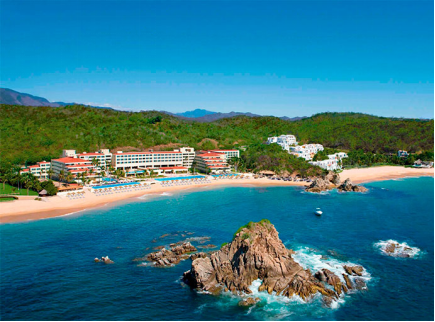
2. Natural geography
Bahias de Huatulco is divided into four main districts. Tangolunda is the area where the large upscale resorts are located; Santa Cruz is a small town with the main marina and Santa Cruz beach; La Crucecita, is another small town just inland from the beach area which provides support services to the area, and Chahué is an area between Santa Cruz and Tangolunda.
The Bahias de Huatulco are a series of nine bays and numerous small coves stretching along 26 kilometers of jagged coastline, including 36 white sandy beaches. The most centrally located bay is Bahía de Santa Cruz, which is just south of the town of La Crucecita. It is also the center of commercial and tourist activities, with a large pier where cruise ships dock. Many resort offerings can be found here such as hotels, craft shops, discothèques, bars, restaurants, excursion agencies, sailboat excursions as well as scuba diving, snorkeling and jet skis for rent. The Capilla de Santa Cruz is where many weddings and baptisms are celebrated next to the sea. Playa Santa Cruz is the best known of the beaches here. It is 250 meters long, with soft white sand and turquoise blue water.
Heading east from Santa Cruz are the bays of Bahía Chahué, Bahía Tangolunda and Bahía Conejos. These are the more developed areas of Huatulco. Bahía Chahué is 2 km east of Santa Cruz and its name means "fertile or moist land" in Zapotec. It has a marina for large and small yachts along with three principal beaches; Chahué, Esperanza and Tejón. Even though these are wide beaches, their moderate surf makes them less-visited than those in Santa Cruz. Three km east of Chahué is Bahía Tangolunda, which has five beaches; Ventura, Manzanillo, Tornillo, Tangolunda and Rincón Sabroso. Here the water varies between cobalt blue and emerald green. Most of the larger hotels are located on this bay. Residencial Conejos is 4 km east of Tangolunda and has some of the larger residential homes in the area, some of which are vacation rentals. The mouth of the Río (River) Copalita is slightly east of Bahía Conejos and it has a long zone of beaches. To the east of Río Copalita are beaches stretching all the way to the Isthmus of Tehuantepec. Two of these beaches are Barra de la Cruz and Playa Mojon. Some great surfing waves can be found from these beaches. Barra de la Cruz is one of the best and easiest to access. Playa El Mojon can, at certain times of the year, have some decent waves for surfing and is also a great location to explore.
To the west of Santa Cruz, the beaches are less developed; in fact most of this area belongs to the Parque Nacional (National Park) Huatulco. This is a protected area (Área Natural Protegida) created in 1998. It contains 6,375 hectares of lowland jungle and 5,516 hectares of marine areas, encompassing the bays of Bahía Maguey, Bahía Órgano, Bahía Cacaluta, Bahía Chachacual and Bahía San Agustín. In these bays live the most important coral communities of the Mexican Pacific. 723 species of animals live in the park as well as a number of species of colorful fish, and it is open to scuba diving, bird-watching and hiking. In 2005, Huatulco was awarded the Green Globe International Certification as a sustainable tourist area. Huatulco was the first sustainable tourist community in the Americas and the third worldwide, after Bali in Indonesia and Kaikoura in New Zealand, to receive this prestigious award because of its development programs for a culture environmentally friendly to conserve its natural resources. Bahía Órgano is named for the cacti that grow there. It is 240 meters long and only accessible by boat. Bahía Maguey is about 1/2 km long and is accessible by car. Both these bays have fine, white sand and waters of various colors of blue and green. Bahía Cacaluta and Bahía Chachacual are only accessible by boat, and there are absolutely no human constructions of any kind. Bahía San Agustín is the furthest west and the largest of all the bays. It has 1 km of beaches between 20 and 80 meters wide. There are also small islets inside the bay itself. Large portions of the Bahias de Huatulco resort area are located within an "ecological zone"; much of the area is protected from future development, and the area is serviced by modern water and sewage treatment plants so that no waste goes into its pristine bays. Huatulco has been awarded the Green Globe certification, and it is the only resort in Mexico to receive this prestigious award (Green Globe is the worldwide benchmarking and certification system for the travel and tourism industry across the triple bottom line of economic, social and environmental management).
The vegetation of Bahías de Huatulco is exuberant, you can find the main tree species, such as the tepeguanje, the Cazarate, the poppy, the ficus, mecianos, the colorin, as well as low thorny forest, thorn scrub, gallery forest and mangrove in the littoral cordon. Its fauna is typical of the neotropical zone, with the absence of large mammals and predators; are the field rats, mice, opossums, badgers, raccoons, armadillos. rabbits, squirrels, white-tailed deer. There is a variety of reptiles and amphibians, including salamanders, toads, frogs, land and aquatic turtles, iguanas, boas, snakes, as well as a wide variety of birds, where the most important are falcons, hawks, owls, pigeons, pelicans, seagulls, magpies, cardinals, calandrias, caciques, carpenters, bunting, sparrows and hummingbirds.
Huatulco is rich in marine fauna. The oysters, lobster, shrimp, dolphin, tuna, dorado, snapper, sailfish and marlin, turtle, red snapper, clam, snail and occasionally whales stand out.
It is worth mentioning that the Huatulco Bays are one of the largest ecosystems in the Mexican Republic to such a degree that President Ernesto Zedillo Ponce de León declared it a protected area that over time became a national park. The first proposal was made by the Secretariats of the Environment, Natural Resources and Fisheries, the Navy and Communications and Transportation in 1997.
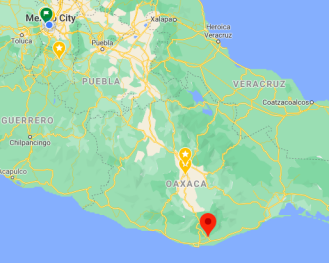
Weather
Köppen Classification: Tropical Savanna Climate
Tropical savanna climates have monthly mean temperature above 18°C (64°F) in every month of the year and typically a pronounced dry season, with the driest month having precipitation less than 60mm (2.36 in) of precipitation. In essence, a tropical savanna climate tends to either see less rainfall than a tropical monsoon climate or have more pronounced dry seasons than a tropical monsoon climate. Tropical savanna climates are most commonly found in Africa, Asia and South America. The climate is also prevalent in sections of Central America, northern Australia and North America, specifically in sections of Mexico and the state of Florida in the United States.
The Köppen Climate Classification subtype for this climate is "Aw". (Tropical Savanna Climate).
The average temperature for the year in Huatulco is 80.2°F (26.8°C). The warmest month, on average, is May with an average temperature of 82.9°F (28.3°C). The coolest month on average is January, with an average temperature of 77.5°F (25.3°C).
The highest recorded temperature in Huatulco is 107.6°F (42°C), which was recorded in February. The lowest recorded temperature in Huatulco is 48.2°F (9°C), which was recorded in January.
The average amount of precipitation for the year in Huatulco is 53.2" (1351.3 mm). The month with the most precipitation on average is September with 11.9" (302.3 mm) of precipitation. The month with the least precipitation on average is December with an average of 0.0" (0 mm). In terms of liquid precipitation, there are an average of 66.7 days of rain, with the most rain occurring in September with 14.5 days of rain, and the least rain occurring in December with 0.1 days of rain.
Getting there and around
Get there
By Air – Huatulco is not as accessible as other coastal areas in Mexico; perhaps one of the reasons why it is as yet less visited than other places. You can get to Huatulco by airplane from the Europe and the USA connecting via Mexico City. Some local air carriers run local flights from Oaxaca, in-season (check locally). The airport is quite close to Huatulco on the northwest side, and a private taxi will take you to your destination. The three main towns around the Bays of Huatulco are Crucecita, Santa Cruz and Tangolunda. Crucecita is the closest and Tangolunda is the farthest away. Your hotel can arrange return transport for you.
By Bus – You can travel to Huatulco on a bus from Mexico City. Bus services are also available from Oaxaca, Acapulco and Puerto Escondido. The bus will leave you in a town nearby called Crucecita (“Little Cross”). From there you can get a taxi or ground transportation to your hotel or resort Huatulco.
By Car – Highway 200 runs south along the coast from Acapulco. The road is well maintained but is mountainous and winding. There is no lighting, either, so we recommend you drive the 200 only drive during daylight hours. There have been some reports of car-jacking on this remote highway; however the authorities, mindful of the importance of tourism, ramped-up the number of police and military patrols along the route and thus dramatically reducing the reported incidents. Highway 175 from Oaxaca City to Huatulco will take about 8 hours to cross: the road is mountainous and, although the scenery is spectacular, it’s a hard and tiring drive. For security reasons, we recommend you travel this road in daylight hours only, whether you go by car or by bus.
Car Rental – To explore Mexico’s provincial towns and cities—including its beach locations and the scenery and attractions near them— consider renting a car for your visit. Having your own car will give you more flexibility than using public transport options and, in some cases, offer you access to places which are otherwise difficult to visit without the use of a car.
Get around
Taxis – Taxis in most of Mexico’s towns and cities are not metered, so agree your price before you get in. Taxi travel is very affordable in Mexico, in comparison to the USA, Canada and Europe, and so provides a viable means of public transportation in Mexico. Your hotel can arrange taxis for you; some post their rates on a board in the lobby; taxi hotel rates are usually higher than cabs you hail off the street. If you speak Spanish, you will have a distinct advantage and be able to negotiate a price with the driver.
Local Buses – Local mini buses run between the three towns and if you’re not weighed down with items you’re carrying, and you’re not in a huge hurry they’re great value as they cost a small fraction of the cost of a taxi.
Uber is expanding rapidly across Mexico and now offers services in cities across the country, including: Mexico City, Toluca, Cuernavaca, Puebla, Querétaro, León, Aguascalientes, San Luis Potosí, Guadalajara, Monterrey, Hermosillo, Tijuana, Mexicali, and Mérida. Uber has been adding Mexican cities to its network every year, check for availability when you arrive at your destination in Mexico.
Cabify is developing also and currently operates in cities including Mexico City, Toluca, Monterrey, Puebla, Querétaro and Tijuana. Check for availability in the city you are visiting.
The services offers people with smartphones a way to book a cab through a mobile app for a pre-agreed price. Fares are comparable with Sitio type cabs (see above), and sometimes trade at a premium to this when local demand increases.
https://www.mexperience.com/travel/beaches/huatulco
https://www.mexperience.com/transport/taxi-travel-in-mexico/#51
3.GDP
GDP: 300 M USD
4. Industry Characteristics
The economy of Huatulco is strongly supported by the tourism and services related to it, with mining and agriculture being some of its other economic activities of relevance.
The dynamism that tourism activity generates over other economic activities is directly observed in terms of the contribution to job creation. The services sector is of greater importance given that it offers more than 61% of the jobs in 1999 and 2004, while in 2009 a decrease of almost ten percentage points (52%) is observed. On the contrary, if you look at the Annual Average Growth Rates (TCMA) the sector that presents positive growth was trade from 24% in 2004 to 34% in 2009. Even in terms of the TCMA it was from 10.66% in 1999 to 41.93%. While the services sector shows relatively low growth with respect to employed personnel
In summary, in the distribution of the jobs generated, the services sector continues to be more important. For example, if the services sector is sub-disaggregated, it is found that the tourist services subsector that ranges from cultural and sports leisure services, temporary accommodation services and food and beverage preparation, has had a growth of 12.22% in the period 2004-2009. While between 1999-2009, the services sector and mining presented the lowest growth rates.
The fact that in the municipality the specialization in the tourist services subsector is reinforced is noteworthy; it is striking that the fishing sector is where the greatest variation of the coefficient was observed. In practical terms, this increase is explained by the decrease in this activity, which has meant a relative increase in the participation of fishermen in the municipality with respect to the state. The commented coefficients give an idea of the economic base of the municipality, with an employment structure in which activities of low productivity and minimal income predominate, which suggests that the expectations of biological and social reproduction of Huatulqueños are centered on temporary employment offered by tourist activity.
In order to conclude the sectoral orientation of the economy, it is necessary to estimate the concentration of primary, secondary and tertiary activities. To quantify the degree of concentration in the primary sector, it represents the sum of the values of agriculture, livestock and forestry, as well as the total brutal production of the fishing sector. This indicator focuses its attention, not so much on the territorial presence of the primary activities, but on their degree of productive efficiency. Therefore, the importance of primary activities in the municipality can be interpreted.
The results found show that in the municipality, primary activities with 5.73%, while activities in the secondary sector 19.29% and activities in the tertiary sector present 79.78%, so it can be concluded that the local economy of the municipality is in the tertiary sector.
http://www.sectur.gob.mx/wp-content/uploads/2015/02/PDF-Huatulco.pdf
5. Touristic sites
Huatulco Beaches
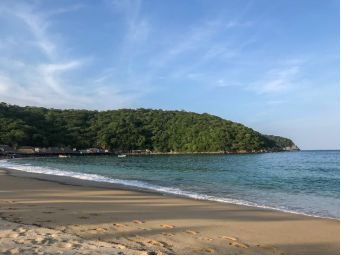
If you’ve come to Huatulco, you’re no doubt here to enjoy a little bit of beach time. Lucky for you this little town is full of them. Every taxi driver we had couldn’t wait to tell us all about the areas nine bays and 30+ beaches (some said 36, others said 37). Many of the beaches are easily accessible by car and are cheap to get to by taxi from the town center, which is called La Crucecita.
The most popular bays are Maguey, Entrega, and Santa Cruz. The bays that are west of town are significantly calmer than those to the east.
Unfortunately, almost all of the resorts are to the east in the bays of Conejo and Tangolunda where the sea is pretty rough. While it’s beautiful to watch the power of the ocean, if you want to swim, it’s best to head to the more popular bays that I just mentioned above.
Bocana del Río Copalita Archeological Site
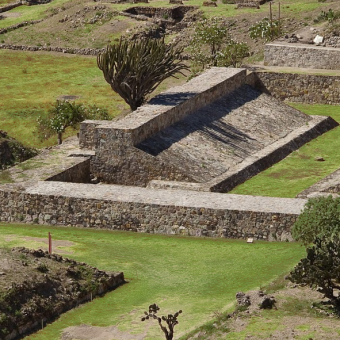
The Bocana del Río Copalita is a 2,500-year-old archaeological site located about ten kilometers from the bays, which is open to the public. The name means "place of copal" and covers an areas of about thirty five hectares. It is believed to have been on the border between Zapotec and Mixtec dominions. Landmarks of the site include a main temple, a temple dedicated to a serpent god, a Mesoamerican ball court and a site museum.
This site is located on the western bank of the Copalita River, very close to the Bahías de Huatulco tourist development. The first occupation of this pre-colonial settlement dates back to the middle pre-classic period (600 BC). At this time, the construction of ceremonial platforms and residential terraces was already manifested on the hills adjacent to the sea cliffs. The classical period is the heyday of this city where there is already a ceremonial center that contains a ball court and a main building more than 20 meters high and which in turn contains, up to now, two tombs associated with the elite ruler.
https://www.inah.gob.mx/zonas/92-zona-arqueologica-bocana-del-rio-copalita
Town Center
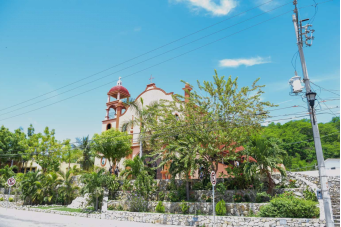
The downtown area of Huatulco is La Crucecita.
It’s a very small town and you’ll likely be able to see the whole town in less than an hour, but it’s still quite a quaint place worth spending some time. The main square is where you’ll find the small church and as the sun begins to set, the main square comes alive. People play music inside the bandstand. Vendors set up along the paths selling souvenirs, bracelets, and ice cream. The restaurants are all open and serving up delicious food. The karaoke bar is blaring out music and La Crema, the towns best bar, is full of people waiting for a free table.
Boat tours off the bays
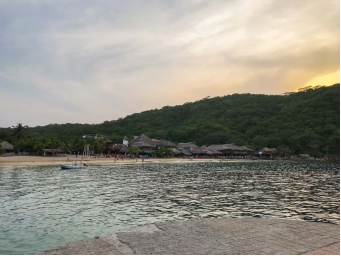
This is one of the best ways to explore the different bays, especially those that you can’t reach by taking a taxi. It’s also a really fun way to get around. Every boat sort of does something different, but the majority of them leave from Bahia Santa Cruz, either straight from the beach or at the pier near the parking lot (it’s right behind the taxi rank).
Boats run pretty much all day long until just before sunset, so you can simply show up at the dock when you want to take a tour and pay. Prices vary depending on how many bays you want to see, whether you want to share a boat with other strangers, and if you want to snorkel along the way.
The typical trip is a private boat tour that costs about 2500 Pesos (about $125 USD) per boat, not per person, which makes this particularly great value if you are a group traveling together. It starts at Marina Santa Cruz and goes all the way to Bahia San Augustin with two stops for snorkeling. You’re usually free to bring your own snacks and drinks. You may be able to negotiate the price of the boat a little bit and many of the people at the docks speak both English and Spanish.
https://www.eternal-expat.com/2019/08/26/things-to-do-in-huatulco
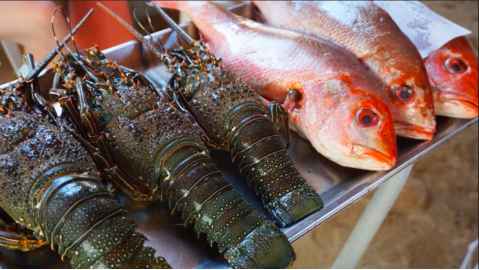
Huatulco Mexico: What to do & Where to Stay
https://youtu.be/Ec1y8aZv1OE
6. History and Culture
Legends say the Toltecs and Quetzalcoatl came from this area. Quetzalcoátl, according to a later legend, set an enormous and indestructible cross. Various people have passed through this area, including the Chatmos, the Zapotecs and the Mexicas.
After the Spanish Conquest, Huatulco thrived as a port under Hernán Cortés's control serving as a vantage point for Spanish galleons and a distribution centre for supplies on the Pacific coast. The latter half of the 16th Century saw Huatulco attacked by Francis Drake and Thomas Cavendish—both of whom left their prints on the region's history and legends that continue to this day.
Until resort development began in the 1980s, Huatulco was little known except as a coffee-growing area. In 1984, FONATUR (Fondo Nacional de Turismo), a government agency dedicated to the development of tourism in Mexico, acquired 21,000 hectares of land to develop a tourism center, similar to that in Cancún. The existing population was relocated to Santa María Huatulco. The plan resulted in the improvement of roadways and other infrastructure. It also has populated areas mixed with "green zones" to make the area ecologically friendlier.
In addition to the beaches, there are small communities of Bahias de Huatulco, such as Santa Cruz, La Crucecita, or old Santa María Huatulco (the municipal seat). Transportation between the communities is available by bus or taxi. The entire area has a "small town" feel about it and is rarely crowded with tourists with the exception of the Christmas and Semana Santa holiday periods.
About 80% of all tourism in Bahias de Huatulco is domestic in nature. Only about 20% of Huatulco's tourism is foreign, mainly because international air access is limited. Bahias de Huatulco has a small international airport just 20 minutes from the main resorts in Tangolunda Bay. This airport has recently increased tourism, and helped to popularize the Pacific Coast backpacker route through Huatulco, Zipolite, Mazunte, and Puerto Escondido.The peak season for foreign tourism is typically from December through April.
Huatulco was declared a UNESCO Biosphere Reserve in 2006.
7. Contact Information
City Mayor: Giovanne González García

Contact number: +52 (958) 581 4402
Govt. Office Address: Constitución SN, Morelos, 70980 Santa María Huatulco, Oax.
FB: https://www.facebook.com/drgiovanne
Website: https://www.huatulco.gob.mx
